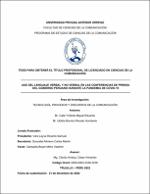| dc.contributor.advisor | Clavijo Arraiza, César Armando | |
| dc.contributor.author | Calle Ynfante, Miguel Eduardo | |
| dc.contributor.author | Ubillús Borrero, Renato Humberto | |
| dc.creator | Calle Ynfante, Miguel Eduardo | |
| dc.date.accessioned | 2023-01-16T16:54:29Z | |
| dc.date.available | 2023-01-16T16:54:29Z | |
| dc.date.issued | 2023 | |
| dc.identifier.uri | https://hdl.handle.net/20.500.12759/10103 | |
| dc.description.abstract | Esta investigación se planteó como objetivo describir el uso del lenguaje verbal y
no verbal en las conferencias de prensa del Gobierno peruano durante la
pandemia de la covid-19. El trabajo fue de tipo cuantitativa descriptiva y no
presentó hipótesis. Se utilizó la técnica de la observación y como instrumento una
ficha de observación para analizar las conferencias de prensa que transmitió por
televisión y a diario el presidente Martín Vizcarra junto a sus ministros, durante
los meses de marzo y abril del 2020. La población estuvo conformada por 25
conferencias de prensa que se emitieron durante los dos primeros meses del
estado de emergencia. Los datos recolectados fueron analizados utilizando
estadística descriptiva y se procedió a la tabulación simple de acuerdo a los
objetivos de la investigación. En los resultados, se presentó un análisis profundo
sobre al uso del lenguaje verbal y no verbal durante las conferencias de prensa
del Gobierno peruano. Uno de los hallazgos significativos fue que en el 100% de
estas actividades se halló evidencia fuerte de uso de mensajes coherentes y con
correcto tono de voz. Finalmente, la investigación concluyó que el uso del
lenguaje verbal y no verbal en las conferencias de prensa del Gobierno peruano
durante la pandemia de covid-19 presentó las siguientes características:
presencia de las funciones del lenguaje (representativa, expresiva y apelativa);
correcto lenguaje corporal, que se evidenció en la firme compostura, firmeza en
las manos y mirada fija de las autoridades. Además, de un correcto empleo del
idioma español acompañado de una fuerza de voz que ayudaban a que el
mensaje llegue de manera clara a la audiencia. | es_PE |
| dc.description.abstract | The objective of this research was to describe the use of verbal and non-verbal
language in the press conferences of the Peruvian Government during the covid 19 pandemic. The work was of a descriptive quantitative type, therefore, it did not
present hypotheses. The observation technique was used and an observation
sheet was used as an instrument to analyze the press conferences that President
Martín Vizcarra and his ministers broadcast on television and daily, during the
months of March and April 2020. The population was made up of 25 press
conferences that were issued during the first two months of the state of
emergency. The collected data were analyzed using descriptive statistics and
simple tabulation was performed according to the research objectives. In the
results, an in-depth analysis was presented on the use of verbal and non-verbal
language during the press conferences of the Peruvian Government. One of the
significant findings was that in 100% of these activities, verbal language was used
correctly by the authorities, since they transmitted coherent messages and with
the correct tone of voice. Finally, the investigation concluded that the use of verbal
and non-verbal language in the press conferences of the Peruvian Government
during the covid-19 pandemic presented the following characteristics: presence
of language functions (representative, expressive and appellative); correct body
language, which was evidenced in the firm composure, firmness in the hands and
fixed gaze of the authorities. In addition, a correct use of the Spanish language
accompanied by a strong voice that helped the message reach the audience
clearly. | en_US |
| dc.description.uri | Tesis | es_PE |
| dc.format | application/pdf | es_PE |
| dc.language.iso | spa | es_PE |
| dc.publisher | Universidad Privada Antenor Orrego | es_PE |
| dc.relation.ispartofseries | T_COM_691 | |
| dc.rights | info:eu-repo/semantics/openAccess | es_PE |
| dc.rights.uri | https://creativecommons.org/licenses/by/4.0/ | es_PE |
| dc.source | Universidad Privada Antenor Orrego | es_PE |
| dc.source | Repositorio Institucional - UPAO | es_PE |
| dc.subject | Comunicación Política | es_PE |
| dc.subject | Pandemia | es_PE |
| dc.title | Uso del lenguaje verbal y no verbal en las conferencias de prensa del Gobierno Peruano durante la Pandemia de Covid - 19 | es_PE |
| dc.type | info:eu-repo/semantics/bachelorThesis | es_PE |
| thesis.degree.level | Título Profesional | es_PE |
| thesis.degree.grantor | Universidad Privada Antenor Orrego. Facultad de Ciencias de la Comunicación | es_PE |
| thesis.degree.name | Licenciado en Ciencias de la Comunicación | es_PE |
| thesis.degree.discipline | Ciencias de la Comunicación | es_PE |
| dc.subject.ocde | https://purl.org/pe-repo/ocde/ford#5.08.00 | es_PE |
| renati.advisor.orcid | https://orcid.org/0000-0003-2338-3238 | es_PE |
| renati.author.dni | 71694095 | |
| renati.author.dni | 77487987 | |
| renati.advisor.dni | 03508280 | |
| renati.type | https://purl.org/pe-repo/renati/type#tesis | es_PE |
| renati.level | https://purl.org/pe-repo/renati/level#tituloProfesional | es_PE |
| renati.discipline | 322999 | es_PE |
| renati.juror | Vera Leyva, Ricardo Samuel | |
| renati.juror | Gonzales Moreno, Carlos Martín | |
| renati.juror | Campaña Boyer, Mirko Vladimir | |
| dc.publisher.country | PE | es_PE |


